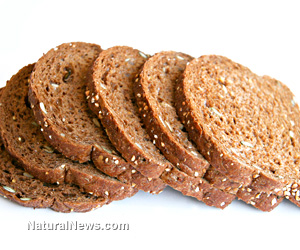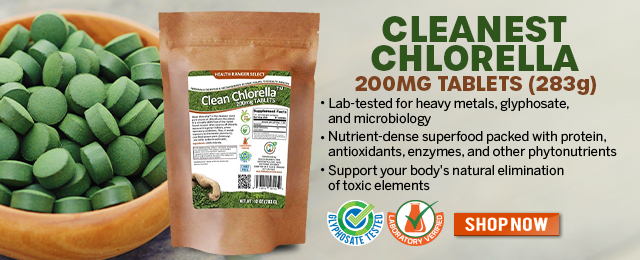
- Widespread social and economic unrest: Steve Quayle issues urgent financial warning of imminent asset collapse in new interview with Mike Adams
- Aerosolized bioweapons? Strange “diploid biomasses” falling out of the sky in Florida captured under the microscope
- U.S. lawmakers investigate Meta over alleged China collaboration
- Israeli lobbyists boast of controlling US national security policy in leaked AIPAC audio
- Analysis: The coming economic collapse, a mass uprising and Trump's three secret weapons to halt the growing revolt
- Fauci is back in the limelight, and he’s busy promoting a future COVID or FLU pandemic
- Kiss Your Genetic Privacy Good-Bye! 23andMe Gets Green Light to Sell Your Intimate Genetic Details to Anyone They Want
- Warp Speed 2.0: Trump Administration ACCELERATES Gates-funded, self-amplifying bird flu vaccines
- Mike Adams releases country western hit single: Goin’ Back in Time is Comin’ Home
- TAKE IT DOWN Act advances in Congress amid free speech concerns
- 6 Seemingly safe US states you should avoid when SHTF
- DMSO and Natural Dyes: A suppressed cancer treatment resurfaces in independent research
- CLOT SHOT PLANDEMIC UNFOLDING: Fibrous, rubbery clots caused by covid injections have prion-like seeding activity
- Tulsi Gabbard leads charge against the Biden regime’s global censorship of the 'Disinformation Dozen'
- Father speaks out: Challenging the mainstream narrative of his daughter’s “unvaccinated measles death”
- Chemical cocktails in processed foods linked to diabetes, validating natural health warnings
- Defunding DEADLY mRNA jabs: Government funding for mRNA technology being scrutinized and sidelined until proven "safe and effective" for real
- Curcumin’s ancient healing power supercharges muscle recovery, and its effects are compounded with anti-inflammatory foods and supplements
- Aerosolized bioweapons? Strange “diploid biomasses” falling out of the sky in Florida captured under the microscope
- Fauci is back in the limelight, and he’s busy promoting a future COVID or FLU pandemic
- Tulsi Gabbard leads charge against the Biden regime’s global censorship of the 'Disinformation Dozen'
- Analysis: The coming economic collapse, a mass uprising and Trump's three secret weapons to halt the growing revolt
- Widespread social and economic unrest: Steve Quayle issues urgent financial warning of imminent asset collapse in new interview with Mike Adams
- Kiss Your Genetic Privacy Good-Bye! 23andMe Gets Green Light to Sell Your Intimate Genetic Details to Anyone They Want
- U.S. lawmakers investigate Meta over alleged China collaboration
- Mike Adams releases country western hit single: Goin’ Back in Time is Comin’ Home
- Israeli lobbyists boast of controlling US national security policy in leaked AIPAC audio
- Chemtrails unveiled: How the CIA and Big Business are manipulating the weather for profit
- Curcumin’s ancient healing power supercharges muscle recovery, and its effects are compounded with anti-inflammatory foods and supplements
- CLOT SHOT PLANDEMIC UNFOLDING: Fibrous, rubbery clots caused by covid injections have prion-like seeding activity
- China’s counter-tariff strategies: A new chapter in the U.S.-China trade war
- Pfizer's RSV vaccine linked to preterm births as drug giant CONCEALED RISKS from pregnant women in unethical clinical trials
- Shedding light on the dark side of MMR vaccines: How vaccinated individuals SPREAD MEASLES & put the vulnerable at risk
- Dane Wigington exposes climate engineering as ‘All-Out Weather and Biological Warfare’
- Defunding DEADLY mRNA jabs: Government funding for mRNA technology being scrutinized and sidelined until proven "safe and effective" for real
- DEATH by VACCINE or face PRISON time: Canadian Freedom Convoy leaders CONVICTED for protesting forced vaccination during the Covid Plandemic
- Newly released JFK files reveal Pentagon's role in creating Lyme disease and covid in the same lab
- Analysis: The coming economic collapse, a mass uprising and Trump's three secret weapons to halt the growing revolt
- Mike Adams releases country western hit single: Goin’ Back in Time is Comin’ Home
- Aerosolized bioweapons? Strange “diploid biomasses” falling out of the sky in Florida captured under the microscope
- Kiss Your Genetic Privacy Good-Bye! 23andMe Gets Green Light to Sell Your Intimate Genetic Details to Anyone They Want
- European Court of Justice: Healthcare professionals who promoted or administered COVID-19 vaccines are CRIMINALLY LIABLE for any harm caused
- Federal employees whine over DOGE's new directive requiring them to do a 5-point summary of weekly accomplishments
- U.S. approves new Russian ambassador as diplomatic thaw continues
- Government waste exposed: Hegseth supports Musk’s demand for accountability from federal workers
- Now you can HEAR chemistry: Health Ranger translates molecules into music in stunning video demonstration that will blow your mind (and your ears)
- Widespread social and economic unrest: Steve Quayle issues urgent financial warning of imminent asset collapse in new interview with Mike Adams
- Dr. Mike Yeadon releases 15-minute testimony - WATCH - about genocidal intent of COVID “vaccines”
- The Health Ranger releases “Vaccine Zombie” song and music video, using AI-animated zombies for the music video
- Trump reverses course on Gaza plan, says “nobody is expelling Palestinians”
- EPA advisor admits the agency is funneling billions to climate groups ahead of Trump’s return to White House
- 5 Simple steps to boost your brainpower: How to strengthen executive function in a distracted world
- I Want My Bailout Money – new song and music video released by Mike Adams
- Tulsi Gabbard leads charge against the Biden regime’s global censorship of the 'Disinformation Dozen'
- Red Cross issues warning to stop blood plasma donations from vaccinated people
- Scientists confirm: GENIUS brain function can be spontaneously unleashed in humans without any apparent cause
- EPA advisor admits the agency is funneling billions to climate groups ahead of Trump’s return to White House
- HYSSOP: What research reveals about the health benefits of this ancient holy herb
- Two containers with completed ballots fall out of truck in Florida
- Newly released JFK files reveal Pentagon's role in creating Lyme disease and covid in the same lab
- Global leaders unite to clamp down on “misinformation” with UN-backed Cascais Declaration
- BREAKING: 2025 NDAA authorizes mandatory military draft of WOMEN across America… as Pentagon pursues global NUCLEAR war with both Russia and China at the same time
- Mike Adams releases country western hit single: Goin’ Back in Time is Comin’ Home
- Michael Yon warns of a ZIONIST TAKEOVER in Trump’s second administration
- Ozempic and Wegovy weight loss drugs are injectable LIZARD VENOM PEPTIDES that may unleash a devastating wave of organ failure… side effects align with symptoms of SNAKE BITES
- The Health Ranger releases “Vaccine Zombie” song and music video, using AI-animated zombies for the music video
- BOMBSHELL: DNA testing kits are a SCAM to develop ethnic-specific bioweapons
- Israeli soldiers accused of even more torture and abuse in the West Bank
- These 13 countries just signed an agreement to engineer a global FAMINE by destroying food supply
- I Want My Bailout Money – new song released by Mike Adams
- NASA admits that climate change occurs because of changes in Earth’s solar orbit, and NOT because of SUVs and fossil fuels
- RFK Jr. clears key hurdle: Sen. Susan Collins backs controversial HHS nominee, signaling a new era for health policy
Yes, gluten seems to be everywhere. It saturates supermarkets, bakeries and restaurants. An elastic protein found in grains like wheat, rye, barley, semolina, spelt, kamut and even oats (thanks to cross contamination that occurs during processing), gluten literally helps to give rise to all manner of bread-like foods. From buns and bagels to cakes and cookies, gluten also assists in achieving the desired texture, kneadability and structure of these foods. That means replacing it with something healthier requires a little education and finesse.
More than 200 conditions associated with gluten toxicity
Education comes first. Surprising though it may be to those who know better, there are some who still argue that the gluten-free diet is just another passing "fad diet." Such a perspective certainly disregards the facts. Even conventional medicine currently acknowledges a small number of disorders likely to stem from the consumption of wheat, including wheat allergy, celiac disease, dermatitis herpetiformis and exercise-induced wheat anaphylaxis. But the truth of the matter is much more bleak.GreenMedInfo has posted a list of more than 200 conditions associated with wheat consumption (http://www.greenmedinfo.com). The list was compiled according to research appearing only in peer-reviewed and published medical journals as indexed by MEDLINE, the National Library of Medicine's biomedical database. In fact, in keeping with the recent exponential increase in interest on the subject of gluten toxicity, the total number of MEDLINE listed studies referencing gluten has also skyrocketed, from 71 studies completed in 1971, to a whopping 514 performed in 2011.
At one time considered a very rare condition, a growing number of studies indicate that celiac disease alone now affects up to one in every 133 people in the United States - a great deal higher ratio than was initially estimated - with general gluten toxicity likely affecting many more, some of whom may not even be aware of what really ails them.
According to Dr. Larry Wilson, M.D., the real cause of celiac disease and other intolerances associated with gluten may actually be a damaged intestinal system. Most people do not secrete enough digestive enzymes to properly digest their food, he says, and most do not drink enough of the correct type of water. At the same time, they're eating foods such as those containing gluten, which subtly irritate their intestinal tract, perhaps even setting off an intestinal infection, making matters worse. He recommends a nutritional balancing program to address this underlying problem.
Get started with gluten-free
For those ready to take the leap away from a gluten-saturated diet, some relief may be found by simply replacing certain items with care; in other cases, a little finesse may be required. Safe, gluten-free substitutions for flours and starches include seed flours (flax, buckwheat, millet, amaranth, quinoa), tuber flours (arrowroot, sweet potato, etc.) and nut flours (almond, walnut, etc.); however, when baking remember it may be necessary to include extra egg whites or other ingredients to improve viscosity, as you are not likely to get the same results from a simple one-to-one flour substitution as you do when using wheat flour. To replace unsafe pasta, bread or noodles, consider brown rice or organic (non-GMO) corn meal. If purchasing at the market, look for those without commercial flavorings.For a more thorough list of substitution ideas, as well as hints on what foods to avoid, please visit Gluten Free Works (http://glutenfreeworks.com/diet-and-health/food-substitutes/) and the Gluten Free Goddess (http://glutenfreegoddess.blogspot.com). And don't forget to check package labels for hidden GMO ingredients.
Sources for this article include:
http://www.greenmedinfo.com
http://glutenfreegoddess.blogspot.com
http://glutenfreeworks.com/diet-and-health/food-substitutes/
https://www.naturalnews.com/035435_gluten_brain_fog_diet.html
http://www.drlwilson.com/ARTICLES/GLUTEN.htm
Gluten at FETCH.news
Get independent news alerts on natural cures, food lab tests, cannabis medicine, science, robotics, drones, privacy and more.
Take Action: Support Natural News by linking to this article from your website
Permalink to this article:
Embed article link: (copy HTML code below):
Reprinting this article:
Non-commercial use OK, cite NaturalNews.com with clickable link.
Follow Natural News on Facebook, Twitter, Google Plus, and Pinterest
Science News & Studies
Medicine News and Information
Food News & Studies
Health News & Studies
Herbs News & Information
Pollution News & Studies
Cancer News & Studies
Climate News & Studies
Survival News & Information
Gear News & Information
News covering technology, stocks, hackers, and more



"Big Tech and mainstream media are constantly trying to silence the independent voices that dare to bring you the truth about toxic food ingredients, dangerous medications and the failed, fraudulent science of the profit-driven medical establishment.
Email is one of the best ways to make sure you stay informed, without the censorship of the tech giants (Google, Apple, Facebook, Twitter, YouTube, etc.). Stay informed and you'll even likely learn information that may help save your own life."
–The Health Ranger, Mike Adams













































